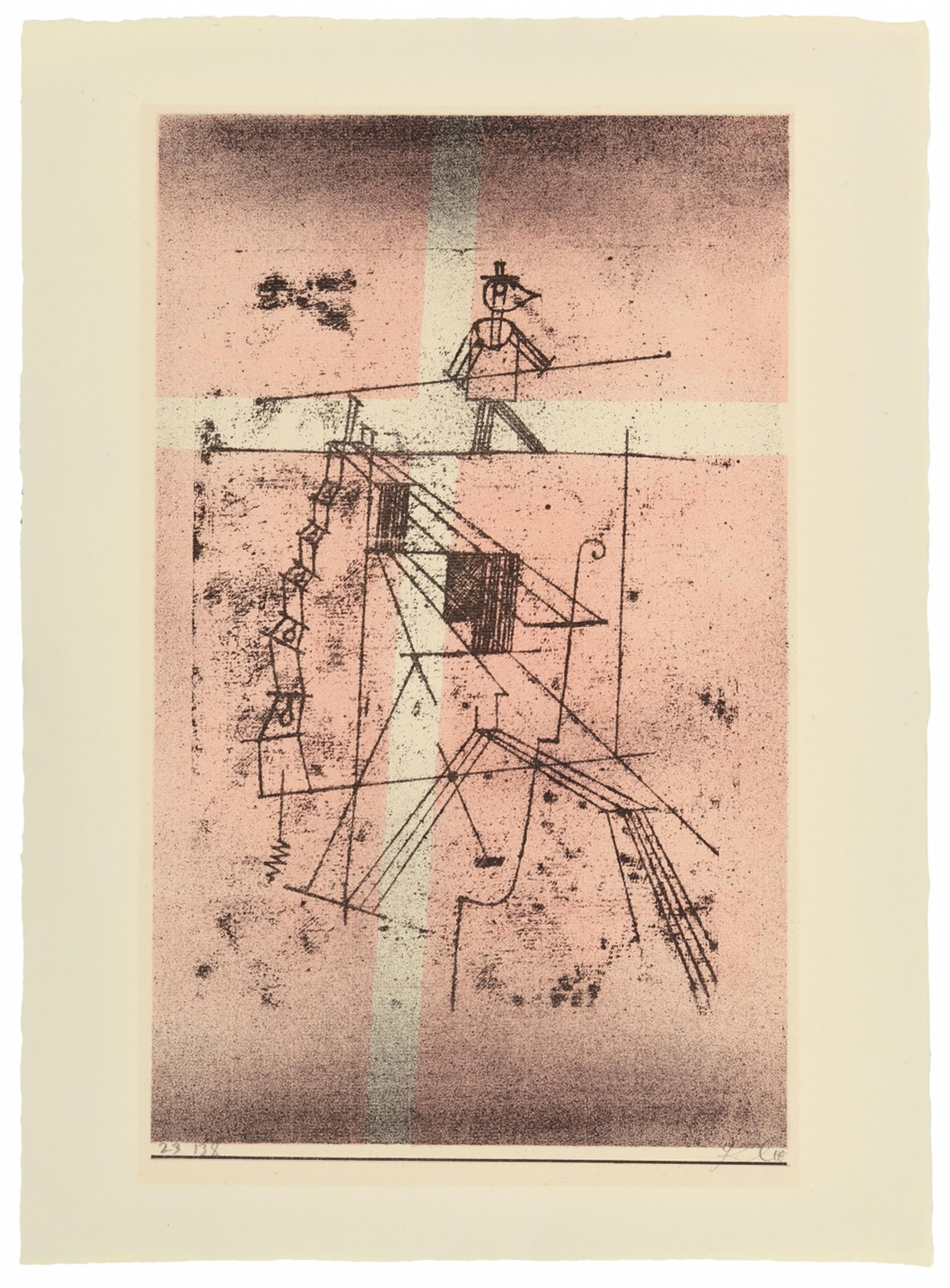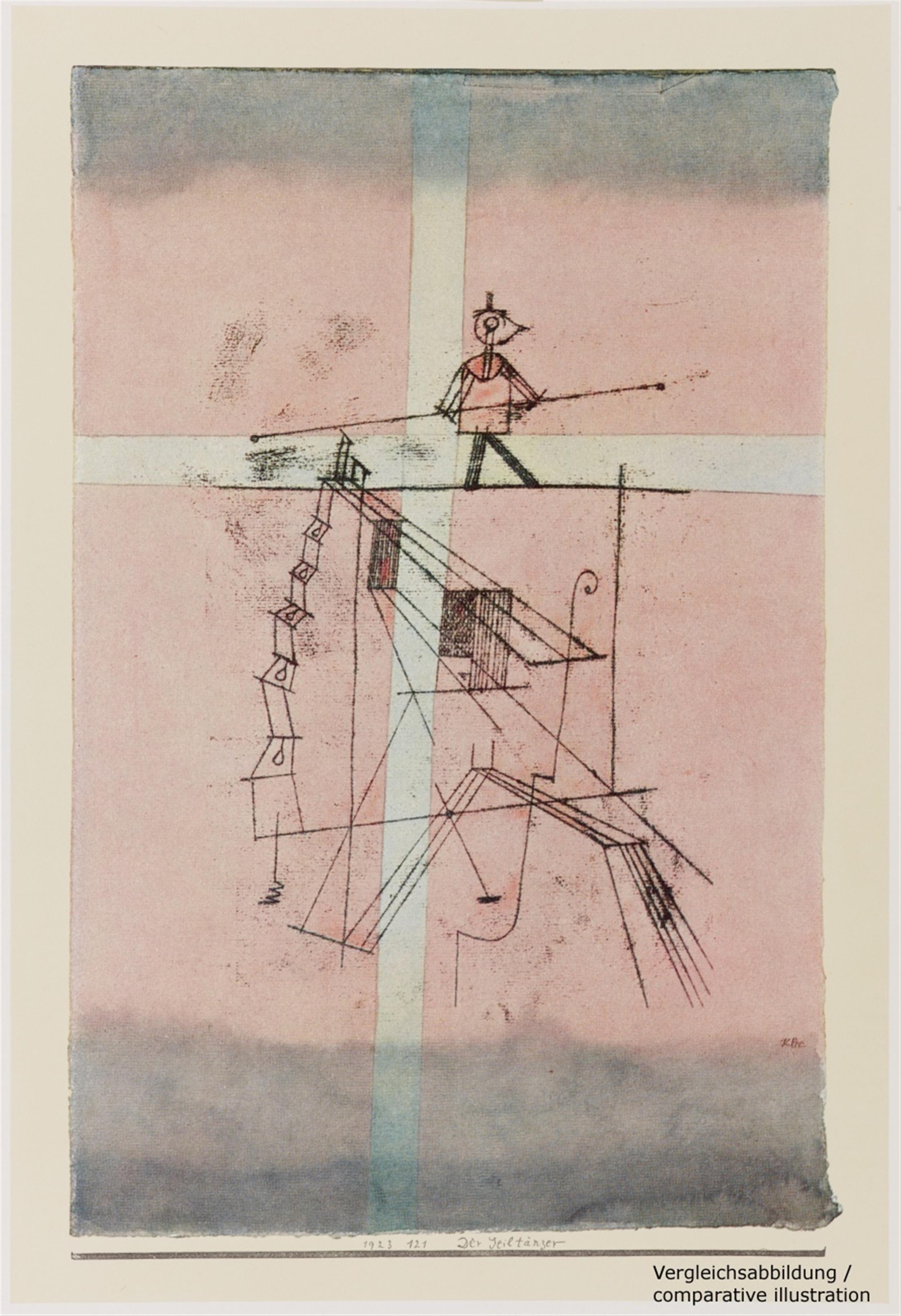Paul Klee
Seiltänzer
1923
Colour lithograph on ribbed laid paper with circular watermark "BSB", oval Ganymed blindstamp of the Marées Society lower right 44 x 26.8 cm (52.3 x 38.2 cm) Signed, dated, and with work number '23 138 Klee'. One of 220 proofs on this paper from a total edition of 300 prints. Sheet IV from the portfolio "Kunst der Gegenwart", Munich, R. Piper / Co., 1923. Printed by Staatliches Bauhaus, Weimar. Publisher of the Marées Society, R. Piper & Co., Munich. - In the original mat of the portfolio edition with the embossing "IV"; the mat opening minimally browned with weak light-stain. Vibrant colours.
“Der Seiltänzer” of 1923 is one of Paul Klee's best-known graphic works. Created in the form of an oil transfer (resp. oil-paint drawing) and watercolour based on a pencil drawing (see cat. rais. 3215, 48.7 x 32.2 as well as 3309, 28.1 x 22 cm, both works from the artist's estate, Lily Klee, Bern), Klee also utilised the motif for the equally famous colour lithograph found here. The print was made at the lithographic printing press in Weimar and published in combination with original prints and photolithographs by other artists in the portfolio “Kunst der Gegenwart”. Artistically it is the most important sheet.
Wolfgang Wittrock has pointed out how different medial and art-making processes mutually influenced one another in Paul Klee's work: drawing, the transfer process (which Klee favoured for lithography) and the oil-transfer technique he developed (Wolfgang Wittrock, Erläuterungen zu Klees graphischen Techniken, in: Paul Klee: Das Werk der Jahre 1919-1933; Gemälde, Handzeichnungen, Druckgraphik, exhib. cat. Cologne 1979, p. 137). For this colour lithograph Klee only used one stone to add tone to the image; in the centre he has left the bars of a constructive cross blank, vertically and horizontally defining the surface area of the ground plane. This static element is equally effective in specifying the coordinates of an imaginary space in which the linear structure and the tightrope walker float, printed in black. Pockets of leftover ink on the print are reminders of the oil transfer technique.
For Klee, drawings were a fundamental means of expression from the very beginning. However, the spontaneity and dynamism in the expressive illustrations of 1911/1912 for Voltaire's “Candide” had by this time made way for a line that has taken over as a medium for expressing a masterful synthesis, a new-found pictorial architecture. In the composition here, this also includes the balanced centring of the graphic motif, without any overlapping or links to the edges.
The “Seiltänzer” is not just a realisation of formal principles from Klee's early teachings at the Bauhaus. The artist has not excluded fantasy and ideas. He seems to metaphorically trace narratives from life in an abstract manner: perils, human naiveties, playful and audacious experiments - not least in matters of love, after all, the tightrope walker hovers above the suggestion of a young woman's profile. His fragile structure and his balance find a solitary anchoring point far below, corresponding to “her” eye. As long as she is there, he is additionally ensured a rescuing means of departure via the ladders and ramps.
The “Seiltänzer” has become a classic visual example for Klee's efforts - articulated early in his career - to “bring architectonic and poetic painting into harmony” (cited in Christian Geelhaar, Paul Klee: Leben und Werk, Cologne 1974, p. 28).
Comparative illustration: Paul Klee, Der Seiltänzer. 1923, 121. (Sonderklasse, von Klee bez. „S.-Cl")
Watercolour over oil colour drawing 48.7 x 32.2 cm
From: Jürgen Glaesemer, Paul Klee. Die farbigen Werke im Kunstmuseum Bern, Bern 1976, p. 216
Catalogue Raisonné
Kornfeld 95 IV.B.b.; Catalogue raisonné, vol. 4, 3232; Söhn HDO 335-4
Provenance
Formerly North German private collection
Literature
I.a.: Will Grohmann, Paul Klee. Handzeichnungen 1921-1930, Potsdam/Berlin 1934, no. 8; Herbert Read (ed.) Surrealism, mit Beiträgen von Herbert Read, André Breton, Paul Eluard et al., with illus.; John Anthony Thwaites, Paul Klee and the Object, in: Parnassus, vol. 9, no. 6, 1937, p. 11; James Thrall Soby, The Prints of Paul Klee, New York 1945, mit Farbabb.; Hans-Friedrich Geist, Paul Klee, Hamburg 1948, p. 27 with colour illus.; Jürg Spilller (ed.) Paul Klee. Das bildnerische Denken. Form- und Gestaltungslehre, vol. 1, Basel/Stuttgart 1956, p. 520 with colour illus.; Eberhard W. Kornfeld, Verzeichnis des graphischen Werkes von Paul Klee, Bern 1963, no. 95 with colour illus.; Sara Campbell (ed.), The Blue Four Galka Scheyer Collection, Pasadena 1976, no. 310; Jim M. Jordan, The Structure of Paul Klee's Art in the Twenties. From Cubism to Constructivism, in: Arts Magazine 1977, p. 155 with illus.; Charles Werner Haxthausen, Klee, The Reluctant Printmaker, in: exhib. cat. Stanford 1979, pp. 9-17, especially p. 12 with illus.; Jürgen Glaesemer, Paul Klee. Handzeichnungen II. 1921-1936, Berlin 1984, p. 20 with illus.; Jim M. Jordan, Paul Klee and Cubism, Princeton 1984, p. 179-181 with illus.; Sara Lynn Henry, Paul Klee's Pictorial Mechanics from Physics to the Picture Plane, in: Pantheon, 47th yr., 1989, pp. 147-165, especially p. 151 with illus.
Exhibitions
I.a.: Dresden (May) 1924 (Galerie Neue Kunst Fides), Paul Klee; Los Angeles (April) 1927 (Los Angeles Museum), European Modernists, no. 54; Dresden 1927 (Graphische Ausstellung des Deutschen Künstlerbundes, Jahresschau Deutscher Arbeit, no. 282; Oakland 1928 (Oakland Art Gallery), Thirty European Modernists, no. 71; Hanover 1931 (Kestner-Gesellschaft Hanover), Paul Klee. Gemälde, Aquarelle, Graphik 1903-1930 ; Düsseldorf 1931 (Kunstverein für die Rheinlande und Westfalen in cooperation with Galerie Alfred Flechtheim) Paul Klee, no. 250; Zurich 1940 (Graphische Sammlung, ETH Zurich), Gedächtnisausstellung Paul Klee 1879-1940, no. 215; Bern/Paris/Brussels 1947/1948 (Kunstmuseum Bern/ Musée National d'Art Moderne/ Palais des Beaux-Arts Brussels), Paul Klee. Ausstellung der Paul-Klee-Stiftung, no. 356; Wuppertal 1956 (Kunst- und Museumsverein Wuppertal), Paul Klee. Werke aus den Jahren 1904 bis 1940, no. 28; Tokyo 1961 (Seibu Museum of Art), Paul Klee, no. 30 with illus.; Saint-Paul-de-Vence 1977 (Fondation Maeght) Paul Klee, no. 253; Berlin/Munich/Bremen 1985/1986 (Bauhaus-Archiv Berlin/ Städtische Galerie im Lenbachhaus/ Kunsthalle Bremen), Paul Klee als Zeichner 1921-1933, no. 26 and 27 with illus.; Martigny 1985 (Fondation Pierre Gianadda) Klee, no. 33 with illus.; Barcelona 1986 (Museo Picasso), Paul Klee dibuixant. 1921/1933 Obres del periode de la Bauhaus, no. 60 and 17; Cambridge 1993 (Busch-Reisinger Museum, Harvard University Art Museum Gallery), Paul Klee, no. 16; Jena 1999 (Stadtmuseum Göhre, Jena), Paul Klee in Jena 1924, p. 262, with colour illus.




